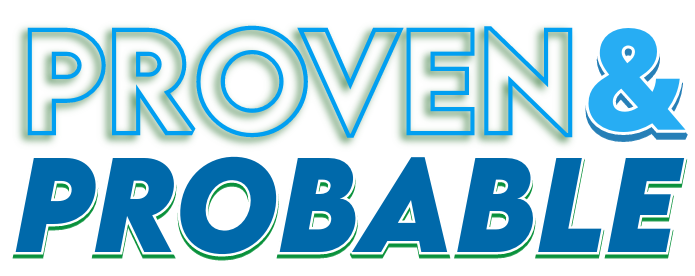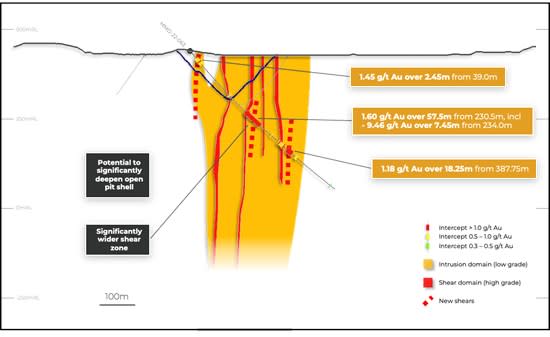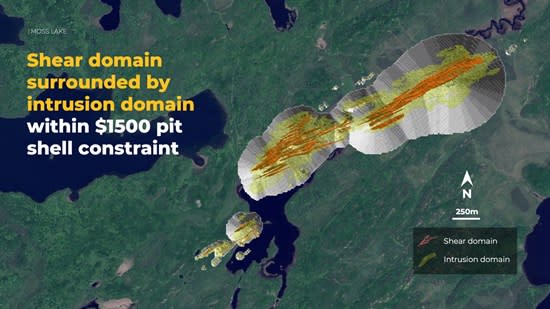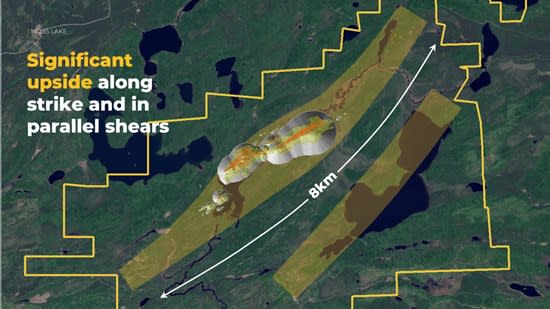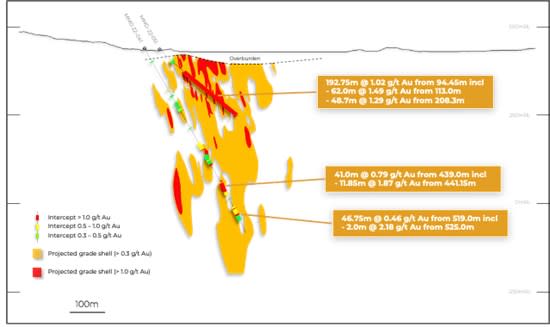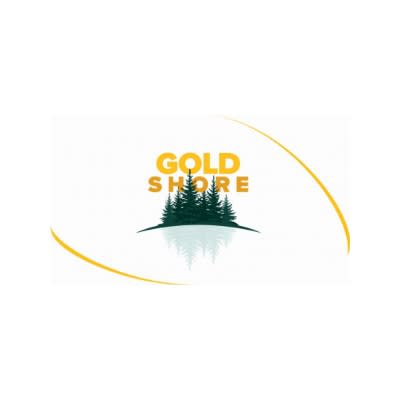Significant Mineralization Outlined 13km Northeast of the Moss Lake Deposit
Vancouver, British Columbia–(Newsfile Corp. – February 27, 2023) – Goldshore Resources Inc. (TSXV: GSHR) (OTCQB: GSHRF) (FSE: 8X00) (“Goldshore” or the “Company“), is pleased to announce assay results from its ongoing 100,000-meter drill program at the Moss Lake Project in Northwest Ontario, Canada (the “Moss Lake Gold Project“).
Highlights:
- Results from the second half of the East Coldstream Phase One drill program have confirmed the potential for significant high-grade shears within East Coldstream, approximately 13 kilometers northeast of the Moss Lake Deposit. Best intercepts include:
- 3.49 g/t Au over 26.35m from 76.85m depth in CED-22-010, including
- 5.64 g/t over 15.65m from 87.55m
- 1.12 g/t Au over 21.9m from 206.5m
- 1.07 g/t Au over 31.0m from 288.0m depth in CED-22-011 and
- 1.48 g/t Au over 18.45m from 357.0m, including
- 4.68 g/t Au over 4.85m from 370.6m
- 4.68 g/t Au over 4.85m from 370.6m
- 0.94 g/t Au over 25.05m from 218.95m depth in CED-22-014, including
- 1.10 g/t Au over 16.0m from 226.0m
- 1.10 g/t Au over 16.0m from 226.0m
- 1.23 g/t Au over 35.15m from 338.45m depth in CED-22-017, including
- 2.19 g/t Au over 11.55m from 338.45m
- 3.49 g/t Au over 26.35m from 76.85m depth in CED-22-010, including
- In addition to the Moss Lake Deposit, the upcoming mineral resource estimate update will include the East Coldstream deposit. In support of this, a 3D wireframe of the mineralization constraining alteration domain has been developed utilizing both current and historical drilling data.
President and CEO Brett Richards stated: “These results at East Coldstream continue to support our thesis that the size and scale of the entire Moss Lake Gold Project will be large enough to support a material and meaningful update to the mineral resource estimate in April 2023, with East Coldstream sequencing into the mine plan in a preliminary economic assessment as a satellite pit. We look forward to the continuing catalysts to the Moss Lake Gold Project in an effort to demonstrate the true value of the assets.”
Technical Overview
Figure 1 shows the location of East Coldstream relative to Moss Lake in addition to the now formally identified gold and copper prospects controlled by Goldshore Resources. Figure 2 shows the better intercepts in plan view, and Figure 3 is a typical section through holes CED-22-013 to -015 and -017. Table 1 shows the significant intercepts. Table 2 shows the drill hole locations.
Figure 1: Plan showing location of Moss Lake and East Coldstream deposits relative to the prospective Central Domain (from geophysics survey) and field-developed prospects.
To view an enhanced version of this graphic, please visit:
https://images.newsfilecorp.com/files/8051/156214_410adcab747ffab5_002full.jpg
Figure 2: Drill plan showing best of several +1 g/t Au intercepts relative to the altered shears.
To view an enhanced version of this graphic, please visit:
https://images.newsfilecorp.com/files/8051/156214_410adcab747ffab5_003full.jpg
Figure 3: Drill section through MCD-22-013 to -015 and -017 relative to the altered shears.
To view an enhanced version of this graphic, please visit:
https://images.newsfilecorp.com/files/8051/156214_410adcab747ffab5_004full.jpg
Results have been received for the eight remaining holes from the Phase One East Coldstream drill program completed in the Summer of 2022.
All holes intersected visually distinct silica, carbonate, and hematite alteration zones hosted in basalt flows – historically been referred to as the “Coldstream Basalt” – that host much of the gold mineralization (Figure 4). This alteration also overprints and locally mineralizes quartz feldspar porphyry sills and gabbro intrusions where they are intersected by shear zones. The altered intrusions are significantly less “visual” than the Coldstream Basalt, which resulted in inconsistent sampling of historical drill core. Infill sampling of intervals within the modelled alteration domain represents an opportunity to expand mineralization. This is planned for the summer.
Goldshore has wireframed shear zone-hosted alteration domains (Figure 5) ahead of a mineral resource update planned for the second quarter. This consists of two major altered shear zones – Main Lens and North Lens – and four minor altered shear zone splays. The Main Lens has been historically split into the Main Lens and Sanders Lens however these two lenses are now understood to be the same zone split by a late Proterozoic diabase dyke.
To evaluate the historical drilling, hole CED-22-010 was drilled as a twin of hole C-10-23 in the core of the East Coldstream deposit where both holes intersected two shear-controlled Lenses. In the North Lens, CED-22-010 and C-10-23 intersected 1.81 g/t Au over 54.6m from 76.85m versus 1.35 g/t Au over 54.2m from 80.4m, respectively. In the South Lens, CED-22-010 intersected 0.56 g/t Au over 51.5m from 206.5m versus 0.55 g/t Au over 34.7m from 196.6m, respectively. This represents a 34% higher grade over similar widths in the North Lens and a 48% increase in width with similar grades in the South Lens in the current drill hole.
The East Coldstream deposit also contains a broad, low-grade mineralized envelope within the alteration domain. Examples include 0.54 g/t Au over 27.5.0m from 562.5m in CED-22-009; 0.56 g/t Au over 51.5m from 206.5m depth in CED-22-010; 0.33 g/t Au over 32.0m from 315m in CED-22-012; 0.72 g/t Au over 18.1m from 182.05m in CED-22-013; 0.69 g/t Au over 25.05m from 254.95m in CED-22-014; and 0.85 g/t Au over 17.4m from 190.6m in CED-22-015.
Figure 4: Core box photos of CED-22-010 intercept in the North Lens – 3.49 g/t Au over 26.35m from 76.85m depth (yellow box) including 5.64 g/t over 15.65m from 87.55m.
Note that these photos are not intended to be representative of broader mineralization on the Moss Lake Gold Project.
To view an enhanced version of this graphic, please visit:
https://images.newsfilecorp.com/files/8051/156214_410adcab747ffab5_005full.jpg
Figure 5: 3D wireframe of the East Coldstream mineralization constraining alteration domain.
To view an enhanced version of this graphic, please visit:
https://images.newsfilecorp.com/files/8051/156214_410adcab747ffab5_006full.jpg
Pete Flindell, VP Exploration for Goldshore, said “These drill results show that East Coldstream, which is well constrained by altered and mineralized shears, may be significantly larger than previously understood. Our focus will now be on developing a mineral resource based around the high-grade shears and their low-grade envelopes, which will form an important satellite to the Moss Lake Gold Project approximately 13 kilometers to the southwest.”
Table 1: Significant downhole gold intercepts
| HOLE ID | FROM | TO | LENGTH (m) | TRUE WIDTH (m) | CUT GRADE (g/t Au) | UNCUT GRADE (g/t Au) |
| CED-22-009 | 497.00 | 511.65 | 14.65 | 11.5 | 0.58 | 0.58 |
| including | 497.00 | 501.00 | 4.00 | 3.1 | 1.20 | 1.20 |
| 562.50 | 590.00 | 27.50 | 22.5 | 0.54 | 0.54 | |
| including | 572.50 | 581.00 | 8.50 | 7.0 | 1.44 | 1.44 |
| CED-22-010 | 76.85 | 103.20 | 26.35 | 16.6 | 3.49 | 3.49 |
| including | 87.55 | 103.20 | 15.65 | 9.9 | 5.64 | 5.64 |
| 123.30 | 131.45 | 8.15 | 5.2 | 0.81 | 0.81 | |
| including | 123.30 | 125.45 | 2.15 | 1.4 | 1.58 | 1.58 |
| 166.00 | 176.50 | 10.50 | 6.8 | 0.59 | 0.59 | |
| 187.00 | 191.00 | 4.00 | 2.6 | 0.56 | 0.56 | |
| 206.50 | 258.00 | 51.50 | 34.5 | 0.56 | 0.56 | |
| including | 206.50 | 228.40 | 21.90 | 14.5 | 1.12 | 1.12 |
| CED-22-011 | 248.40 | 251.75 | 3.35 | 2.0 | 1.49 | 1.49 |
| including | 248.40 | 251.00 | 2.60 | 1.6 | 1.73 | 1.73 |
| 284.50 | 324.60 | 40.10 | 24.8 | 0.91 | 0.91 | |
| including | 288.00 | 319.00 | 31.00 | 19.1 | 1.07 | 1.07 |
| 339.00 | 344.50 | 5.50 | 3.5 | 0.70 | 0.70 | |
| 357.00 | 375.45 | 18.45 | 11.8 | 1.48 | 1.48 | |
| including | 370.60 | 375.45 | 4.85 | 3.1 | 4.68 | 4.68 |
| 400.40 | 413.90 | 13.50 | 8.8 | 0.54 | 0.54 | |
| including | 400.40 | 404.45 | 4.05 | 2.6 | 1.25 | 1.25 |
| CED-22-012 | 315.00 | 347.00 | 32.00 | 20.7 | 0.33 | 0.33 |
| 362.80 | 367.00 | 4.20 | 2.8 | 0.57 | 0.57 | |
| 376.80 | 381.05 | 4.25 | 2.8 | 0.52 | 0.52 | |
| CED-22-013 | 119.00 | 121.00 | 2.00 | 1.5 | 1.14 | 1.14 |
| 137.65 | 149.85 | 12.20 | 9.1 | 0.41 | 0.41 | |
| 182.05 | 200.10 | 18.05 | 13.9 | 0.72 | 0.72 | |
| including | 182.05 | 194.40 | 12.35 | 9.5 | 1.02 | 1.02 |
| CED-22-014 | 31.00 | 33.00 | 2.00 | 0.9 | 0.96 | 0.96 |
| 119.00 | 133.00 | 14.00 | 6.5 | 0.39 | 0.39 | |
| 218.95 | 244.00 | 25.05 | 12.5 | 0.94 | 0.94 | |
| including | 226.00 | 242.00 | 16.00 | 8.0 | 1.10 | 1.10 |
| 254.95 | 259.00 | 4.05 | 2.0 | 0.36 | 0.36 | |
| 264.00 | 280.00 | 16.00 | 8.1 | 0.95 | 0.95 | |
| including | 271.00 | 277.00 | 6.00 | 3.1 | 1.68 | 1.68 |
| CED-22-015 | 9.00 | 11.00 | 2.00 | 1.3 | 0.70 | 0.70 |
| 21.00 | 23.00 | 2.00 | 1.3 | 0.42 | 0.42 | |
| 31.00 | 33.00 | 2.00 | 1.3 | 0.33 | 0.33 | |
| 118.00 | 120.00 | 2.00 | 1.4 | 0.31 | 0.31 | |
| 190.60 | 208.00 | 17.40 | 12.6 | 0.85 | 0.85 | |
| including | 190.60 | 195.80 | 5.20 | 3.7 | 1.20 | 1.20 |
| and | 206.00 | 208.00 | 2.00 | 1.4 | 1.95 | 1.95 |
| CED-22-017 | 212.80 | 221.00 | 8.20 | 6.3 | 0.53 | 0.53 |
| 284.00 | 286.00 | 2.00 | 1.6 | 0.68 | 0.68 | |
| 298.00 | 305.00 | 7.00 | 5.7 | 0.69 | 0.69 | |
| 338.45 | 373.60 | 35.15 | 29.6 | 1.23 | 1.23 | |
| including | 338.45 | 350.00 | 11.55 | 9.7 | 2.19 | 2.19 |
| and | 362.90 | 373.60 | 10.70 | 9.1 | 1.28 | 1.28 |
| Intersections calculated above a 0.3 g/t Au cut off with a top cut of 30 g/t Au and a maximum internal waste interval of 10 metres. Bordered intervals are intersections calculated above a 1.0 g/t Au cut off. Intervals in bold are those with a grade thickness factor exceeding 20 gram x metres / tonne gold. True widths are approximate and assume a subvertical body. |
Table 2: Location of drill holes in this press release
| HOLE | EAST | NORTH | RL | AZIMUTH | DIP | EOH |
| CED-22-009 | 680,767 | 5,386,281 | 484 | 341° | -50° | 599.95 |
| CED-22-010 | 679,898 | 5,386,424 | 475 | 161° | -53° | 315.00 |
| CED-22-011 | 679,945 | 5,386,526 | 480 | 155° | -57° | 642.00 |
| CED-22-012 | 679,945 | 5,386,526 | 480 | 180° | -54° | 600.00 |
| CED-22-013 | 680,560 | 5,386,569 | 485 | 340° | -50° | 300.00 |
| CED-22-014 | 680,561 | 5,386,569 | 485 | 341° | -65° | 450.00 |
| CED-22-015 | 680,598 | 5,386,576 | 486 | 340° | -50° | 300.00 |
| CED-22-017 | 680,641 | 5,386,434 | 478 | 341° | -49° | 456.00 |
| Approximate collar coordinates in NAD 83, Zone 15N |
Analytical and QA/QC Procedures
All samples were sent to ALS Geochemistry in Thunder Bay for preparation and analysis was performed in the ALS Vancouver analytical facility. ALS is accredited by the Standards Council of Canada (SCC) for the Accreditation of Mineral Analysis Testing Laboratories and CAN-P-4E ISO/IEC 17025. Samples were analyzed for gold via fire assay with an AA finish (“Au-AA23”) and 48 pathfinder elements via ICP-MS after four-acid digestion (“ME-MS61”). Samples that assayed over 10 ppm Au were re-run via fire assay with a gravimetric finish (“Au-GRA21”).
In addition to ALS quality assurance / quality control (“QA/QC”) protocols, Goldshore has implemented a quality control program for all samples collected through the drilling program. The quality control program was designed by a qualified and independent third party, with a focus on the quality of analytical results for gold. Analytical results are received, imported to our secure on-line database and evaluated to meet our established guidelines to ensure that all sample batches pass industry best practice for analytical quality control. Certified reference materials are considered acceptable if values returned are within three standard deviations of the certified value reported by the manufacture of the material. In addition to the certified reference material, certified blank material is included in the sample stream to monitor contamination during sample preparation. Blank material results are assessed based on the returned gold result being less than ten times the quoted lower detection limit of the analytical method. The results of the on-going analytical quality control program are evaluated and reported to Goldshore by Orix Geoscience Inc.
Director Resignation
Doug Ramshaw has announced he will step down from the Board of Directors of the Company at the end of February 2023. Doug was instrumental in the formation of Goldshore and the preliminary launch of the initial public offering in June 2021, and is stepping down to dedicate greater time to Minera Alamos and other ventures he is involved in.
President and CEO Brett Richards stated: “Doug’s exceptional contribution to the Goldshore Board has been a testament to the broad investor awareness created around the Company’s launch and on-going development. I personally have thoroughly enjoyed working with Doug over the last two years, as he has been sound counsel to myself and the Board, and on behalf of all of us on the Board, we wish Doug the very best in his future endeavors.”
About Goldshore
Goldshore is an emerging junior gold development company, and owns 100% of the Moss Lake Gold Project located in Ontario. Wesdome is currently a large shareholder of Goldshore with an approximate 22% equity position in the Company. Well-financed and supported by an industry-leading management group, board of directors and advisory board, Goldshore is positioned to advance the Moss Lake Gold Project through the next stages of exploration and development.
Peter Flindell, P.Geo., MAusIMM, MAIG, Vice President – Exploration of the Company, a qualified person under NI 43-101 has approved the scientific and technical information contained in this news release.
Neither the TSXV nor its Regulation Services Provider (as that term is defined in the policies of the TSXV) accepts responsibility for the adequacy or accuracy of this release.
For More Information – Please Contact:
Brett A. Richards
President, Chief Executive Officer and Director
Goldshore Resources Inc.
P. +1 604 288 4416 M. +1 905 449 1500
E. brichards@goldshoreresources.com
W. www.goldshoreresources.com
Facebook: GoldShoreRes | Twitter: GoldShoreRes | LinkedIn: goldshoreres
Cautionary Note Regarding Forward-Looking Statements
This news release contains statements that constitute “forward-looking statements.” Such forward looking statements involve known and unknown risks, uncertainties and other factors that may cause the Company’s actual results, performance or achievements, or developments to differ materially from the anticipated results, performance or achievements expressed or implied by such forward-looking statements. Forward looking statements are statements that are not historical facts and are generally, but not always, identified by the words “expects,” “plans,” “anticipates,” “believes,” “intends,” “estimates,” “projects,” “potential” and similar expressions, or that events or conditions “will,” “would,” “may,” “could” or “should” occur.
Forward-looking statements in this news release include, among others, statements relating to expectations regarding the exploration and development of the Moss Lake Gold Project, the release and timing of an updated mineral resource estimate, the release of a preliminary economic assessment and other statements that are not historical facts. By their nature, forward-looking statements involve known and unknown risks, uncertainties and other factors which may cause our actual results, performance or achievements, or other future events, to be materially different from any future results, performance or achievements expressed or implied by such forward-looking statements. Such factors and risks include, among others: the Company may require additional financing from time to time in order to continue its operations which may not be available when needed or on acceptable terms and conditions acceptable; compliance with extensive government regulation; domestic and foreign laws and regulations could adversely affect the Company’s business and results of operations; the stock markets have experienced volatility that often has been unrelated to the performance of companies and these fluctuations may adversely affect the price of the Company’s securities, regardless of its operating performance; and the impact of COVID-19.
The forward-looking information contained in this news release represents the expectations of the Company as of the date of this news release and, accordingly, is subject to change after such date. Readers should not place undue importance on forward-looking information and should not rely upon this information as of any other date. The Company undertakes no obligation to update these forward-looking statements in the event that management’s beliefs, estimates or opinions, or other factors, should change.
This news release does not constitute an offer to sell, or a solicitation of an offer to buy, any securities in the United States. The securities have not been and will not be registered under the United States Securities Act of 1933, as amended (the “U.S. Securities Act”) or any state securities laws and may not be offered or sold within the United States or to U.S. Persons unless registered under the U.S. Securities Act and applicable state securities laws or an exemption from such registration is available.

To view the source version of this press release, please visit https://www.newsfilecorp.com/release/156214
